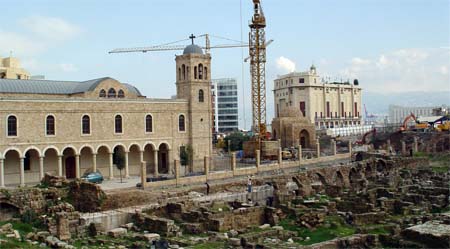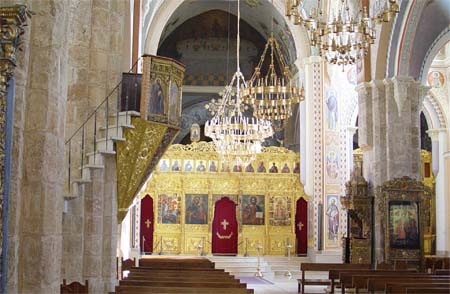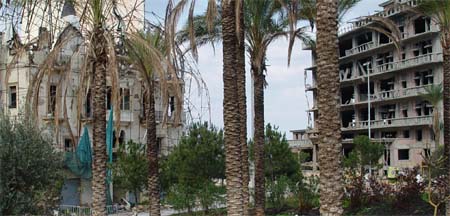I got a rather disquieting reaction when I asked one of the Armenian monks what bus I should take to go downtown. His first suggestion was that he would recruit a student to go with me. When I protested that I didn’t want anyone to go to any trouble, he asked one of the junior clerics, a native of Beirut, to give me directions. “Well,” he said, “you take the overpass to the other side of the highway and then you stop a bus, any bus, or a taxi — but get into a taxi that already has passengers, otherwise you might be taken advantage of.” (As a greenhorn I could be treated to an expensive ride.) I asked Mariam to write out in Arabic my destination (Downtown: “Wasat el Madina”) and “Antelias” (our town) so that, in a pinch, I could show the Arabic text to a driver to get the ride I would need.
Up the overpass to the otherside of the highway, within seconds of taking position on the curb, direction south to the city, a privately owned and operated bus pulled over, a well-worn Toyota mini-van with a capacity of about 8 passengers seated (and quite a bit more in a squeeze, literally). I showed my piece of paper and muttered, “Wasat el Madina.” “Na-am, na-am,” (yes, yes) or such was the reply, and then in reasonably good French, “On ne va pas jusqu’à là, mais on peut vous amener dans la bonne direction.” (Not going that far, but can get you part of the way.) I climbed aboard. Ten minutes later, a rapid transfer to another mini-van for the remaining portion of the journey, and I was soon dropped off downtown, “Wasat al Medina!” (For a whopping total fare of 1,250 Lebanese Pounds (LL), or just under a Canadian dollar.)
The above taken through a clear window, looks into the heart of the Greek
Orthodox Cathedral of St. George, traditionally said to mark the site of St.
George’s slaying of the dragon. For centuries a granite column marked the spot
of the slaying, and was said to have miraculous healing power. Richard the Lion
Hearted and other English crusaders, adopted the cult of St. George, bring home
the legend of the heroic saint who would become England’s patron. I’m told he is
still greatly revered, in the region, by Muslim and Christian alike.
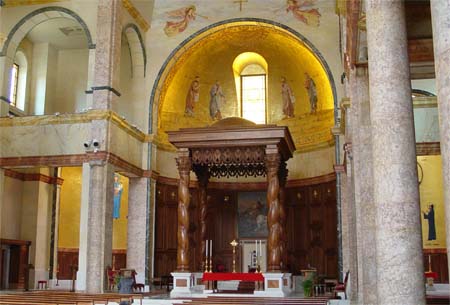
Near Place de l’étoile, the Maronite Cathedral of St. George, above. Like much of the district, the building shows signs of extensive repair from damage in the civil war (1975-1990). A wonderful building, with a gracious caretaker and guide. A “je vous en pris.” answered my “merci beaucoup.”
 Just next door to the Cathedral, the
vast new Sunni mosque “Mohammed el-Amine” — a gift to the city from billionaire
Rafik Hariri, at a cost of $20 million. It is one of many on-going efforts to
raise a new Beirut from the rubble of war. There’s room here for 6,400 faithful.
Tragically, it is now the final resting place of its assassinated benefactor and
former Lebanese Prime-Minister, along with his six body guards and one of his
rescuers also killed in the suicide bombing
of nearly a year ago.
Just next door to the Cathedral, the
vast new Sunni mosque “Mohammed el-Amine” — a gift to the city from billionaire
Rafik Hariri, at a cost of $20 million. It is one of many on-going efforts to
raise a new Beirut from the rubble of war. There’s room here for 6,400 faithful.
Tragically, it is now the final resting place of its assassinated benefactor and
former Lebanese Prime-Minister, along with his six body guards and one of his
rescuers also killed in the suicide bombing
of nearly a year ago.
The ravages of war are still readily visible in the towering shell of the bombed out Holiday Inn, which I learn is slatted for a refurbishment. The buildings pictured below give eerie testimony to the current political climate. Pictured here, the site of the Rafic Hariri assassination, Feb. 14, one year ago (2005).
Yet, the beauty of Lebanon and its crown jewel Beirut, manage to overcome
the hulking ghosts of the past. I stroll among dozens of locals out for a midday
promenade by the sea. Bellow, the Café d’Orient. Look carefully, very carefully,
and distant snow capped peaks glimmer above the café’s windows — a haze today
prevented a clearer picture.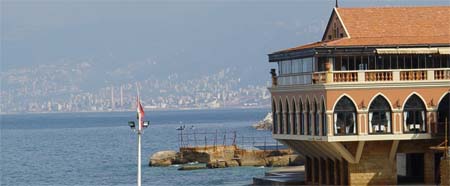
And this, a sign of hope reborn and courageous vision cut into the damaged facade of Beirut’s own Hard Rock Café …
“The time will come when you see we are all one.” - The Beatles
Home on the mini-van circuit was certainly more “interesting” — and it took
about three times as long, but cost only 1,000 LL (80 cents). Two rides needed
for the return trip as well: the first with a driver whose only European
language was German (He once worked in Germany for 7 years.) I was surprised to
find that my limited knowledge of the language was sufficient — All told 5
languages used today (French, English, Armenian, Arabic, and German!) The driver
let me off at a busy corner to catch the Number 2 bus to Antelias — an LCC
vehicle (public transit), as battered and worn as all the others but about the
size of a small school bus in Canada. At one point the Number 2 got so crowded
that one passenger was more outside than in, but good humour and remarkable
courtesy prevailed throughout.
Tomorrow another mini-van journey, this time
to the seminary in Bickfaya, but fortunately Fr Moses, also a teacher there, will
be my companion and guide.










